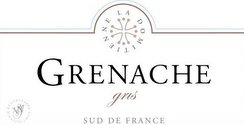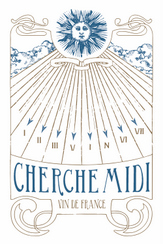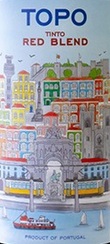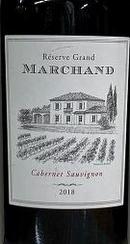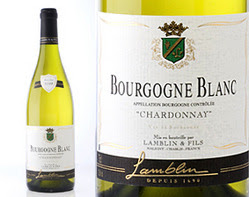
Lamblin et Fils Bourgogne Blanc
Declassified Chablis never tasted as good as this delectable wine from the highly conscientious Lamblin estate. The high toned aromatics are just the beginning, as the wine resolves with crisp apple, honey and a hint of minerals. An outstanding value to say the least. Delicious!
One of the more prolific houses in Burgundy, this Chablis-based firm has been under family control for 300 years now and run by Didier Lamblin and his brother Michel.
Home base for Lamblin is on the northern edge of the village of Maligny, which is also the northernmost tip of the region’s Kimmeridgian soils.
You can think of Lamblin as a “hybrid” negociant – About 20% of Lamblin’s production comes from their own vineyard land, and the remainder from partner growers. We’ve long found tremendous value in their Bourgogne Rouge and Bourgogne Blanc bottlings, and those remain our focus from Lamblin in terms of selection.
100% Chardonnay. Meticulous sorting, fermentation and aging in steel. Pale-yellow color. Rich fruity nose, which offers beautiful citrus-fruit aromas, evolving into ripe fruits with peach dominating. This Bourgogne Chardonnay offers a good attack and is fresh and round in the mouth.
David Large Côte de Brouilly Heartbreaker
David Large is another new star in Beaujolais, a place where there are many, exciting new winemakers changing the perceptions of what Beaujolais can be. Barely 35, David Large has all the credentials one would hope for in a winemaker: a family history of winemaking stretching back to 1840, diplomas from the elite schools, and experience working with the greats. Nonetheless, he views becoming a great winemaker to be a process of “unlearning”.
His vineyards are located in pockets around Montmelas, a beautiful and mountainous area of the Southwest Beaujolais. The soil types of David’s wines are predominantly granite, clay and the “Pierres Dorées”, a local and unique limestone formation pigmented with iron oxide. His wines also benefit from a volcanic rock base uniquely suited to Gamay vines.
He does everything himself, down to driving the delivery truck and composing the verses inscribed on the side of his wine labels – David is an enthusiastic rapper and poetry aficionado. Even the names of the individual wines are personal.
Like Pierre Cotton, David Large has his labels well sorted. You can’t beat a bit of nostalgia for the cassette tape! David’s vines on the Mont de Brouilly are on Piedmont soils. I was informed that these are in fact “diorite”, with which I’m more familiar. Diorite is a soil type apparently not “volcanic” but formed from volcanic activity.
Yields are very low and the wines undergo a semi-carbonic maceration in concrete tanks for 14 days, after which the must is pressed, and finishes fermentation in fibreglass vats. Sulphur is added, but just 2g/litre. The wine is focused and fresh with very nice fruit.
This Côte de Brouilly has real density in the mouth, with fine raspberry and cherry fruit flavors. While it is pretty, it also has structure: grainy and delicious.
Kopriva Chardonnay (sustainable)
Kopriva Chardonnay We’ve been carrying this lively and bright unoaked Carneros Chardonnay since their first commercial vintage; both staff and customers love its fresh attack, lack of malo-lactic fermentation, and crisp and clean mouthfeel.
It’s a perfect foil for most lighter foods, as the lack of oak and butter flavors complements anything from soups to fish, to poultry. All the Chardonnay grapes are from vineyards within the Carneros American Viticultural Area (AVA) of Sonoma County.
It’s an unoaked, stainless steel fermented, 100% Chardonnay without any secondary fermentation. Noted for its cooler growing season of morning fog, afternoon wind and cold nights, the Carneros AVA allows the grapes to slowly develop mature flavors while maintaining high acidity. This enables Kopriva to produce a crisp and delicate white wine that exhibits the highest qualities the Chardonnay grape can express.
The SF Examiner agrees: “Kopriva embraces all of what Chardonnay can be, a reflection of a place, in this case, the Carneros AVA in Sonoma County. The terroir yields a purity of fruit from a cool climate of fog and wind which allows the grapes to slowly develop ripe flavors but still keep the acidity high….”

Lascaux Garrigue Blanc
The vineyards of Château de Lascaux have been in the family for thirteen generations. The name of the domain, “Lascaux” comes from a limestone specific to the domain’s vineyard sites.
Jean-Benoît Cavalier took direction of the property in 1984, just after finishing a degree in Agricultural Engineering. In 1990, he consolidated the vineyards, restructured the ancient cellars, and created the official domain, Château de Lascaux. Today, over twenty-five years later, the domain has expanded from 60 to 210 acres of vineyards, surrounded by 750 acres of forest, filled with green oaks, pines, and garrigue**.
The quiet isolation of this part of the region, coupled with its proximity to both the sea and the mountains, makes this microclimate so unique. It is nestled along the foothills of the Cevennes, a mountain range that sits in the heart of the Midi. These foothills protect the vines from the cool Mistral and Tramontagne winds, and bring more rain to an otherwise dry climate. That this temperate zone brings a long, slow ripening of the grapes only adds to the wines’ complexity. The stony soil lends finesse and freshness to his wines, giving the reds greater aging potential than Syrah-based wines grown in other Languedoc soils.
The proliferation of garrique certainly is reflected in the aromatics, where notes of laurel, thyme, rosemary, réglisse, and mint are present in the wines. Jean-Benoît is passionate about supporting the richness and diversity of this ecosystem, so the domaine’s conversion to organic viticulture was a logical choice. There is a freshness and purity, finesse and complexity in the Lascaux wines that is rare in this wild landscape. The consistency of the winemaking, the quality of their wines, and great values they present make this domaine a treasure.
Not far from the Languedoc’s spectacular vertical limestone outcropping known as Pic Saint Loup, thirteenth-generation vigneron Jean-Benoît Cavalier runs the historic Château de Lascaux. While Pic Saint Loup is renowned for its red wines and also has an appellation dedicated to rosé, the area is equally conducive to the production of high-quality whites. Situated at the foot of mountains that bring cool winds and close enough to the Mediterranean to benefit from its moderating influence, the vines enjoy perfect conditions to achieve balanced ripeness year after year. This blend of Rolle (Vermentino), Roussanne, Marsanne, and Viognier combines a sun-kissed roundness on the palate with the crisp liveliness conferred by the unique microclimate and rocky limestone soils. With notes of lemon and garrigue herbs plus a stimulating mineral element, the Lascaux blanc is the ideal match for Mediterranean fish preparations. Alternatively, chill a bottle for your apéritif and savor its breezy freshness.
**Garrigue refers to the low-growing vegetation on the limestone hills of the Mediterranean coast, not the limestone itself. There are a bunch of bushy, fragrant plants that grow wild there, such as juniper, thyme, rosemary and lavender, and garrigue refers to the sum of them
La Domitienne Grenache Gris
The vineyards are the property of the Bonfils Family and occupy sections in the sub areas of Minervois and Corbieères. The name La Domitienne is named after the ancient road, Via Domitian which divides the two growing zones, one in the North and the other in the South. The Via Domitia was the Roman road that allowed Roman soldiers to control all of Southern Gaul.
The Mourvèdre Rosé is 85% Mourvedre and 15% Grenache, from three vineyards in the Mont Baudile, Domaine de Saint-Saturnin region. The wine was fermented with indigenous yeast, aged in stainless steel and cement tanks. Trace amounts of sulfur were added at bottling.
The Grenache Gris Rosé is from St Guilhem le Désert region. Saint-Guilhem-le-Désert is a commune in the Hérault department in the Occitanie region in southern France. Situated in the narrow valley of the Gellone river where it meets the steep-sided gorge of the Hérault River, Saint-Guilhem-le-Désert is essentially a medieval village located on the Chemin de St-Jacques pilgrim route to Santiago de Compostella. Like the Mourvèdre, the wine was fermented with indigenous yeast, aged in stainless steel and cement tanks. Trace amounts of sulfur were added at bottling.
Cherche Midi Red (Organic)
The Cherche Midi wines are blended especially for Paris Wine Company by Benjamin Beguin and Aurore de Fleurieu from organically-farmed, estate vineyards in Montfrin, located at the border between the Rhône Valley and the Languedoc. The wines are crafted to be enjoyable, easy to drink straight away, and to offer great value for organic wine from the south of France.
The vineyards were originally planted by Aurore’s father, Jean-René de Fleurieu. There’s a lot to say about his illustrious and intellectual family. His grandfather was the founder of Les Echos, a national economic newspaper, and his grandmother was a radical feminist senator. Jean René is also a filmmaker and co-founded the well-known Paris fashion brand, Agnes B. He also has a wooly mammoth skeleton in his tank room. Jean-René grew up in Montfrin, and in 1993, he decided to plant 100 hectares of olive trees and 100 hectares of vines in order to create local jobs and make delicious and affordable wines that have always been produced organically.
In colloquial French, a “cherche midi” or “noon-seeker” means someone who is looking to invite themselves in for a free lunch, so this bottle is a perfect tool to have in hand for all the “Cherche Midis” out there.
60% Syrah, 30% Grenache, 10% Cabernet, this wine is medium bodied with aromas of blackberries and baking spices. On the palate there are flavors of dried raspberry, blackberries, rosemary, black pepper, and savory, spiced charcuterie.
Topo Red Blend (Sustainable)
Casa Santos Lima was created several generations ago by Joaquim Santos Lima, who, by the turn of 19th century, was already a great producer and exporter of Portuguese wines. Maria João Santos Lima and José Luís Santos Lima Oliveira da Silva, granddaughter and great grandson of the founder, relaunched Casa Santos Lima in 1990, replanting most of the vines, improving agricultural techniques and modernizing all its productive structure. Since 1996, Casa Santos Lima, started bottling its own brands , which immediately achieved great success both in national and international markets.
I have visited the winery, and remain amazed that they are able to produce so many wines (over 60 different labels) at such a sustained quality level, especially for the price. We used to carry one of their wines, but changes in distributors had raised the price so that it is no longer a value, and we have replaced it with this bottling. Same grapes, same fermentation, different label.
This super fun wine is characterized by its aromatic exuberance, with notes of red fruits and vanilla. In the mouth it is fruity with velvety notes of red ripe fruits, balanced by spice, chocolate, and just a hint of oak. An elegant wine with soft tannins and a fruity finish.
Previously destemmed, the grapes went through a low temperature pre-fermentative maceration for 24 hours. The alcoholic fermentation was completed at low temperatures in stainless steel vats for 14 days. Skin contact maceration with (submerged) cap for 28 days. Partial ageing in oak barrels.
Wine Spectator: “This bright and juicy red offers brambly fruit, graphite and peppery spice notes bound together by tangy acidity. Light tannins offer grip on the herb-tinged finish. Castelão, Tinta Roriz, Syrah and Touriga Franca.”
Reserve Grand Marchand Bordeaux
This 100% Cabernet Sauvignon wine comes from the eastern ends of the Entre-deux-Mers appellation (which is designated for whites only, thus the generic “Bordeaux” label). It is full of black fruits that balance the firm, dry tannins. Juicy acidity bursts in at the finish. Winner of a gold medal from the Concours Générale Agricole de Paris.
Réserve Grand Marchand belongs to the Barthez Family. Jean Marc Barthez, his wife Eliane, and their children are working at the property and in their vineyard with the care and the experience of old generation vine growers.

Domain Jomain Bourgogne Blanc (Sustainable)
If you’re like me and love white Burgundy, you’ve been priced out of many of your favorites over the past years. That $30 Puligny-Montrachet is now over $100, and the once bargain of St.Aubin is now in the $50-60 range.
A true family enterprise, brothers Philippe and Christophe Jomain, along with sister Catherine, launched this Chardonnay focused Cote de Beaune domaine in 1992 with vines inherited from their father, Marc. With precious parcels in four of Puligny’s premier crus and almost an acre of hallowed ground in the Grand Cru Batard Montrachet, Domaine Jomain consistently produces a line of classically elegant white Burgs.
The Jomain tend all their vineyards meticulously by hand with careful eco-sound practices, including bio-alternative vine and soil treatments in lieu of chemicals whenever possible. Harvest is of course also manual. From vineyard to the cellar, gentle handling of their Chardonnay fruit is of paramount importance.
In the cellar, Christophe takes every measure to ensure that the individual character of each terroir is fully expressed by avoiding manipulative technological tricks and excessive use of new oak. The Jomain do like the texture-enhancing effects of extended lees contact with batonnage, but never use more than 25% new barrels during the elevage of their wines.
The Jomain family are best known for creating superb Puligny-Montrachet. And this is your chance to taste their expertise at a lower price. Once the grapes are hand-picked and pressed, this wine is aged partially in oak.
This Bourgogne Blanc is produced in the same commune and offers a good level of interest for the reasonable price. Green gold in the glass, the aromas are spicy and buttery, with some white flowers, stone fruit and citrus. Aged in steel and oak for a total of 12 months, This dry, white wine offers fruity aromas of lychee, pear, lemon, and apple while the hint of earthy mushroom adds complexity. Light, crisp, and clean, this is textbook Bourgogne.

Adroît Initiative Mission (Organic, Natural)
Seabold Cellars is the brainchild of Master Sommelier Chris Miller. Seabold Cellars was established in the Monterey Bay region because they believe that cool-climate vineyards produce balanced wines that showcase their origin more than their winemaking. Their approach is as hands-off as possible, respecting traditional techniques and practices without being beholden to them.
Their Adroît Initiative wines are the outcome of successful experiments in the winery that do not quite fit into a traditional mold. They represent a divergence from what is generally considered the more ‘classic’ winemaking archetypes: pétillant-naturel, carbonic maceration, skin-contact white wines, and underappreciated grape varieties typically find a home in The Adroît Initiative.
The natty kids would call both of these wines glou-glou, eminently gulpable wines.
Mission grapes are a variety of Vitis vinifera introduced from Spain to the western coasts of North and South America by Catholic New World missionaries for use in making sacramental, table, and fortified wines. It is grown in South America, particularly in Chile and Peru, under then names Criolla and Pais. During the 19th century, the grape was known by several other names, including the Los Angeles grape and the California grape.
Seabold’s Mission (aka Päis) bottling is from a single vineyard (Somers) in the cooler Mokelumne River subregion of the Lodi AVA. Boasting the coolest climate of the Lodi, with a mild Mediterranean climate influenced by proximity to a number of the Sacramento Delta’s waterways, the soils are very consistent with a mild slope draining off to the river.
Hand-harvested in the early morning. Upon entering the winery, the clusters were hand-sorted prior to loading into harvest bins, which were subsequently sealed airtight. From the small pool of free-run juice, fermentation began and flooded the bins with CO2, initiating carbonic maceration inside of the grapes. Two bins were opened and pressed off after 10 days, finishing primary in barrel, and the other bins at 20 days.
The wine was aged on fine lees in neutral barriques. After five months, the wine is racked and bottled unfined and unfiltered.
Look for juicy red cherries, cranberries, raspberries, forest floor, potpourri spice, and a bit of white pepper, with a long, soft, velvety finish. Serve chilled
Lioco Indica Red ( Practicing Organic)

Lioco wines were born out of ideas that germinated in the alley behind Spago-Beverly Hills in 2001. Matt Licklider was the national sales director for North Berkeley Imports, and Kevin O’Connor was the Wine Director at Spago.
The pair would taste wine in the alley, spitting in the rain gutter, and talk about the wines they loved and lament that there weren’t enough domestic wines that fit their preferences: lower alcohol, less sugar, and putting elegance and nuance before power.
Those conversations and the resulting friendship gave birth to Lioco in 2005. They’ve been at the avant-garde of the current trend of wine-making that champions less intervention in the process and looks to the California wines of the 1980s (and older) as well as European wines as benchmarks.
Farming is, at a minimum, sustainable. All grapes are hand-picked and sorted.
All fruit was hand-harvested in late September. It was foot tread and fermented beneath a ‘submerged cap’ on 100% whole clusters during an 18-day fermentation. It spent 10 months in neutral oak prior to bottling.
From two historic Mendocino County vineyards—one with 70-year-old, dry-farmed Carignan (93%) pitched on an exposed, rocky slope at 2,400 feet; the other with 75+-year-old Valdiguié (7%) farmed on clay soils in a cool, upland valley. These rapidly vanishing California grape varieties harken back to the Golden State’s earliest winemaking efforts.

Clos de Sixte Lirac (Organic)
Established in 1826 in the Northern part of Chateauneuf du Pape, the Alain Jaume Winery boasts both the exceptional terroir of the Southern Rhone Valley and a long line of dedicated winemakers. Alain Jaume works in accordance with certified organic agricultural practices for both the Grand Veneur and Clos de Sixte vineyards. They strive to let the true terrior be expressed in their wines.
The principal winemaker is Alain Jaume. His sons Sebastien and Christophe are both heavily involved with the winery in sales and marketing and winemaking respectively. The Alain Jaume winery consists of 40 acres in Chateauneuf du Pape, 50 acres in Lirac, and 75 acres of Cotes du Rhone vines.
The family produces wines under two labels: Domaine Grand Veneur and Alain Jaume.
93 points Wine Enthusiast: Fleshy plum and black-cherry flavors are juxtaposed by dark shades of anise, crushed granite and sage in this bold, richly textured wine. Polished and penetrating, the wine is lifted by tangs of crushed mineral on the midpalate. It drinks beautifully now but should continue to improve through 2026.
93 points Robert Parker’s Wine Advocate The 2016 Lirac Domaine du Clos de Sixte is a terrific wine, easily the rival to many Châteauneufs from across the river, starting with its alluring aromas of flowering garrigue and ripe cherries. A blend of 50% Grenache, 35% Syrah and 15% Mourvèdre, this full-bodied wine is lush and concentrated on the palate, then turns velvety on the long finish. I’d treat it like a Châteauneuf du Pape in terms of cellaring: hold it for a few years, then drink it over the next 15.
92 points Jeb Dunnuck Year in, year out, the Clos de Sixte Lirac is a superstar wine, and the 2016 Lirac Clos De Sixte doesn’t break the trend. Made from 50% Grenache, 35% Syrah, and the rest Mourvèdre, brought up in 30% oak, this beauty boasts loads of dark fruits, peppery herbs, graphite, and crushed rock. Medium to full-bodied, rich, and powerful, it stays polished and elegant on the palate, with the beautiful 2016 purity of fruit front and center. Drink it any time over the coming 7-8 years.





